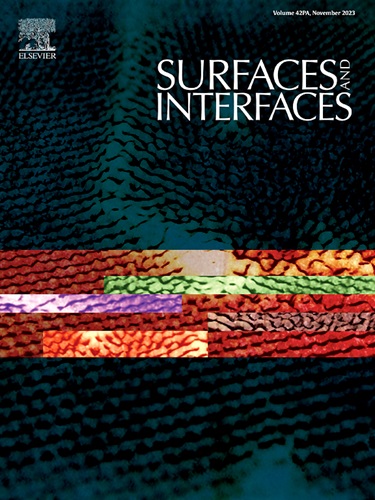Novel UiO-66(Ce)/CdS/g-C3N4 ternary nanocomposite with boosted photoactivity in the degradation of the dye rhodamine B
IF 5.7
2区 材料科学
Q2 CHEMISTRY, PHYSICAL
引用次数: 0
Abstract
Metal-Organic Frameworks (MOFs) are a category of porous material recognized for their tuneable structures and high surface areas, making them promising candidates for various applications, including photocatalysis. Among these, UiO-66(Ce) has attracted significant attention from the scientific community due to its impressive redox capabilities, effective ligand-to-metal charge transfer, and effecient charge-hole separation. This study reports the successful synthesis of novel ternary nanocomposite that combined UiO-66(Ce) with CdS and g-C3N4. The physicochemical characterization was addressed using XRD, XPS, FE-SEM-EDS, EDS mapping, FTIR, TGA, N2 adsorption-desorption isotherms, PL and DRS-UV–vis techniques. These studies confirm the effective formation of heterojunction nanocomposite materials. The ternary nanocomposites were evaluated as photocatalysts in the degradation of the dye rhodamine B, achieving degradation rates of 97.5 % and 99.5 % within 120 min under visible light and sunlight systems, respectively. These rates significantly surpassed the photocatalytic performance of the individual components and their binary combinations. The results highlight significant synergistic effects within the heterostructures, enhancing the transfer of charges across interfaces and bettering the separation of light-generated electron-hole pairs. The produced active intermediates, including hydroxyl radicals (•OH), superoxide anions (•O2-), and holes (h+), exhibited nearly equivalent quenching effects. Furthermore, the synthesized ternary nanocomposite demonstrated remarkable stability and recyclability, maintaining considerable performance over at least five cycles. A potential reaction mechanism for the photocatalytic process has also been suggested.
新型UiO-66(Ce)/CdS/g-C3N4三元纳米复合材料降解染料罗丹明B的光活性增强
金属有机框架(mof)是一类多孔材料,以其可调谐的结构和高表面积而闻名,使其成为包括光催化在内的各种应用的有希望的候选者。其中,UiO-66(Ce)因其令人印象深刻的氧化还原能力、有效的配体-金属电荷转移和有效的电荷-空穴分离而受到科学界的广泛关注。本研究成功合成了UiO-66(Ce)与CdS和g-C3N4的新型三元纳米复合材料。采用XRD、XPS、FE-SEM-EDS、EDS图谱、FTIR、TGA、N2吸附-脱附等温线、PL和DRS-UV-vis技术对其进行了理化表征。这些研究证实了异质结纳米复合材料的有效形成。该三元复合材料作为光催化剂对染料罗丹明B的降解效果进行了评价,在可见光和日光系统下,120 min的降解率分别为97.5%和99.5%。这些速率明显超过了单个组分及其二元组合的光催化性能。结果表明异质结构内部具有显著的协同效应,增强了电荷在界面上的转移,并改善了光产生的电子-空穴对的分离。所产生的活性中间体,包括羟基自由基(•OH)、超氧阴离子(•O2-)和空穴(h+),表现出几乎相同的猝灭作用。此外,合成的三元纳米复合材料表现出显著的稳定性和可回收性,在至少五个循环中保持相当大的性能。本文还提出了光催化过程的潜在反应机理。
本文章由计算机程序翻译,如有差异,请以英文原文为准。
求助全文
约1分钟内获得全文
求助全文
来源期刊

Surfaces and Interfaces
Chemistry-General Chemistry
CiteScore
8.50
自引率
6.50%
发文量
753
审稿时长
35 days
期刊介绍:
The aim of the journal is to provide a respectful outlet for ''sound science'' papers in all research areas on surfaces and interfaces. We define sound science papers as papers that describe new and well-executed research, but that do not necessarily provide brand new insights or are merely a description of research results.
Surfaces and Interfaces publishes research papers in all fields of surface science which may not always find the right home on first submission to our Elsevier sister journals (Applied Surface, Surface and Coatings Technology, Thin Solid Films)
 求助内容:
求助内容: 应助结果提醒方式:
应助结果提醒方式:


